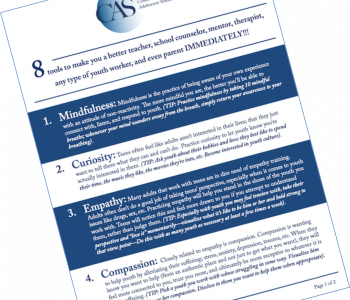

Catharine Hannay, MA
Catharine Hannay is the founder of MindfulTeachers.org and the author of Being You: A Girl’s Guide to Mindfulness, a workbook for teen girls on mindfulness, compassion, and self-acceptance.
6 Tips for Practicing Self-Care (Even When You Have No Time for Yourself)
Your schedule is so packed you can’t possibly fit in any time for self-care.
I get it. I really do.
But I’m still going to tell you that you have to fit in some time for self-care.
Here’s why:
I nearly had a nervous breakdown when I was working a full-time administrative position while developing a new curriculum and teaching multiple new classes.
I was so overwhelmed I couldn’t think straight, which meant I made it even harder on myself because I was “too busy chasing cows to build a fence.”
As Stephen Covey puts it,
“Suppose you came upon someone in the woods working to saw down a tree. They are exhausted from working for hours. You suggest they take a break to sharpen the saw. They might reply, ‘I don’t have time to sharpen the saw, I’m busy sawing!’”
I discovered that I was actually more effective (not to mention a lot happier and a lot easier to live with!) when I worked six days a week instead of seven, and when I stopped working at eight o’clock at night instead of ten.
There are likely many aspects of your life, work, and schedule that you can’t control. Here are a few tips to help you figure out what you can control, so you can free up some time and energy to focus on your own needs.
Tip #1: Say ‘No’ to Any More Commitments
You are a kind, responsible person, and you really, truly want to help everyone all the time.
But if you’re already overwhelmed, it isn’t kind to yourself or others to take on any additional responsibilities that aren’t absolutely essential.
Kevin DeYoung gives the example of being asked to coach your daughter’s soccer team when your scheduled is already packed.
“Reluctantly, you say yes. Good move or bad move? That depends. Maybe you said yes […] because you want to spend time with your daughter and you want to influence the lives of her teammates. But just as likely, you said yes because you didn’t want to let people down and you didn’t want to disappoint the person making the request.”
(Crazy Busy, p. 40)
Psychologist Whitney Goodman says that even in your work, “You may have to set limits with people when you don’t have the energy, resources, or qualifications to assist them, and that is OK.”
“In fact, it’s the healthy and ethical thing to do. […] Directing someone to other resources or saying that you can’t help doesn’t mean that you don’t care or that you’re abandoning them. It means that you are trying your best to provide them with the right resources, while also giving yourself the ability to set limits and care for yourself.”
(Toxic Positivity, p. 206)
Tip #2: Work with Whatever You’ve Got
If you can’t take a day off, can you take half a day? A couple of hours? Twenty minutes? Five minutes? Thirty seconds?
Here’s how one woman managed to take a daily lunch break at hectic emergency shelter:
“She would close her door and spread out a white paper napkin on her desk, arrange her modest meal on her makeshift placemat, and, to the best of her ability, eat her food in relative peace and quiet.”
(Laura van Dernoot Lipsky, Trauma Stewardship)
After that moment to herself, she felt refreshed enough to head back into the fray.
As for me, even on the craziest of days I’ve always managed to squeeze in enough time to eat half a sandwich. That leaves me much better off than when I used to feel shaky all afternoon from skipping lunch.
Tip #3: Chaos-Proof Your Self-Care Routine
It’s easy to slip into a very unhealthy lifestyle when ‘survival mode’ goes on for too long. If you’re dealing with a long-term crisis or exceptionally busy period at work, you may need to ease up a bit, but it’s important not to completely let go of your healthy habits.
For example, I try to take a walk every day, no matter what else is happening in my life. At various points this has meant:
- hiking around a small lake near my home;
- taking quick breaks from correcting piles of research papers by strolling up and down the hallway after every ten pages; and
- pacing the hospital corridors while waiting for a family member to recover from surgery.
It would be lovely if I could stroll around the lake every single day, but that’s unrealistic. Taking a walk every day is something I can do no matter what else is happening in my life. (Except when I had to take a few weeks off while recovering from a foot injury, so I did chair-based exercises instead.)
Tip #4: Try the ‘Bucato Technique’
You’ve probably heard of the Pomodoro Technique, which was not named for Signore Pomodoro but for the tomato-shaped timer used by Francesco Cirillo.
I developed the ‘Bucato Technique’ when I was an English teacher figuring out how much homework I could correct while my clothes were in the wash (il bucato).
The problem with multitasking is that we’re usually trying to concentrate on two different tasks that would both benefit from our full attention. In contrast, the Bucato Technique involves figuring out how to get something done while waiting for something else to finish on its own.
There’s likely a few items on your to-do list that you can ‘bucato’ to free up a time for self-care later in the day. Or you could ‘bucato’ your self-care, perhaps by taking a quick stroll or a mini meditation break while waiting for a meeting to start or for your bus to arrive.
Tip #5: Take a ‘Tired and Crabby’ Day
When I wasn’t feeling well, I told my students “I have a headache today, so if my facial expression or tone of voice makes it seem like I’m in a bad mood, it has nothing to do with you.” I also explained that I was hoping to go home right after class, so if they had any non-urgent questions I’d prefer to wait until the next day.
It’s much kinder to let folks know what’s going on than to have them wonder if they’ve somehow offended you. And most people will be supportive if they know you’re feeling out of sorts that day, especially if a) you generally have a good rapport with them, b) you don’t do this too often, and c) you’re supportive of them on their own Tired and Crabby Day.
Tip #6: Ask Yourself “What Do I Really Need Right Now?”
While I was recovering from the flu a few days ago, I caught myself doing nothing but sipping my tea and staring at the washing machine.
It was a bit ironic, since I’d already written the section of this post on The Bucato Technique.
And that’s OK.
Clearly the priority that morning wasn’t efficiency. What I most needed was rest.
Self-care can mean very different things on different days. Sometimes it might mean letting go of all your responsibilities for an evening. At other times it might mean pushing yourself to get more exercise or to finally make that healthcare appointment you’ve been putting off for weeks.
Conclusion
I hope these tips help you figure out ways to focus on your own needs in the midst of all your other commitments. Self-care isn’t about being selfish or shirking your responsibilities. It’s about maintaining your health and sanity by making choices about how to spend your available time and energy.
New habits are best tended to when we agree to join in with others. The simple act of agreeing to do something with someone else adds a bit of helpful accountability and the social aspect of it (in many instances, itself a form of self-care!) makes it less of a “chore”. To join an online community of like-minded professionals dedicated to self-care and resilience practices, join the FREE Training Community today!
Related Posts
How Can I Focus on Self-Care When There’s Endless Need?
How Can I Help Others When I’m Struggling Myself?
5 Ways to Practice Self-Care When You’re Exhausted and Overwhelmed

